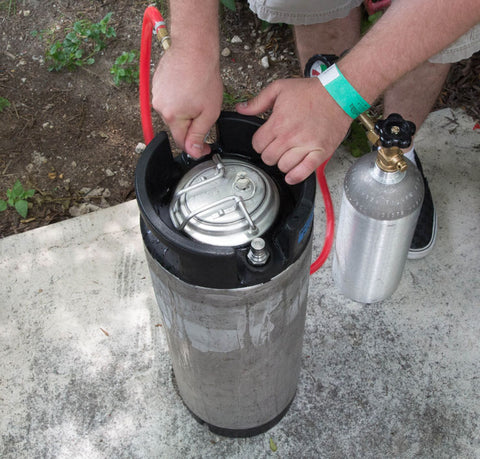The Liber team recently collaborated with Genius Gin and the talented Mr. Moody to keg a gin and tonic, featuring our Premium Tonic Syrup.
The project was one that had enticed us long ago, and we finally had the opportunity to feature the kegged G&T at the rip-roarin' birthday party of a couple of bartender friends, Travis Tober of The Four Seasons Austin and Whitney Hobbs of Whisler's. It should be of little surprise that putting a craft gin and tonic on tap was a booming success.
The project was one that had enticed us long ago, and we finally had the opportunity to feature the kegged G&T at the rip-roarin' birthday party of a couple of bartender friends, Travis Tober of The Four Seasons Austin and Whitney Hobbs of Whisler's. It should be of little surprise that putting a craft gin and tonic on tap was a booming success.
HERE'S HOW WE DID IT
The principles of kegging anything-- be it beer or spirit-- are pretty straightforward. The goal is to push as much CO2 into the keg as possible, while eliminating the presence of oxygen.
The keg we were working with had a 5 gallon capacity. Converted to ounces, this means we were making a 640 ounce drink.
FOR OUR RECIPE, we went with a 2 : 0.75 : 3 (gin : Tonic Syrup : water) serving ratio. For us, this amounted to about 6.75 1 L bottles of gin and about 5 17 oz. bottles of our Tonic Syrup, and served roughly 111 gin and tonics!

The secret to rich, long-lasting carbonation is solubility--specifically the ability of CO2 to dissolve in water. The solubility of gasses in water tends to decrease with temperature. This means that achieving maximum carbonation of your tapped cocktail requires making the beverage as cold as possible prior to charging, during the charge, and during consumption.
OUR METHOD OF QUICKLY COOLING the non-carbonated G&T base prior to charging was simple and violent.
We crushed cubed ice with a gavel and poured it directly into the gin and tonic syrup mixture (perhaps purchasing crushed ice would have been more practical, though we're convinced that doing it our way is somehow more... handcrafted). This served both purposes of adding the necessary water for dilution, as well as chilling the entire cocktail prior to charging.
The result was a lovely gin and tonic slushy which, on another day, we might have enjoyed by itself.

NEXT COMES CARBONATING the G&T. Our buddy Matt's setup involved a 5 gallon keg, along with a 5 lb. CO2 tank. This is a particularly party-friendly rig, as it is very portable and requires little time to successfully charge.
Running the tank at 50 psi, the 5 gallon keg took us only 5-10 minutes to fully carbonate. The trick when pushing the CO2 into the keg is to periodically close the CO2 tank and release air from the release valve at the top of your keg. This will release some of the CO2 you just pumped in, but will also serve to expel unwanted oxygen from inside the keg.
It's also generally helpful to agitate the keg itself during the charging process. This serves to ensure that the CO2 is thoroughly diffused throughout the G&T, and can be done by either rocking the keg back and forth or by rolling the keg back and forth on the ground a-la coffee can ice cream.
I wish there were some tried and true rule of thumb for exactly how long carbonating takes. Alas, there are simply too many variables involved in the process for such inflexibility. Instead rely on some simple, intuitive guidelines.
- The longer you charge the keg, the more carbonated your beverage will be.
- Generally the higher the alcohol content of your beverage, the longer the carbonation time.
- Throughout the entire process-- from loading the keg through joyous consumption-- the keg needs to be kept as cold as possible. The colder the liquid inside the keg, the longer the CO2 will remain in solution. No one likes a flat G&T.
Yours in spirits,
Liber & Co.
